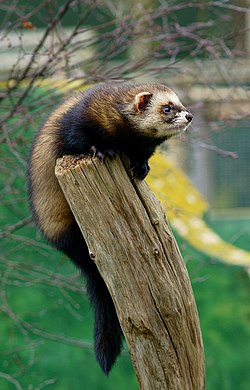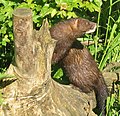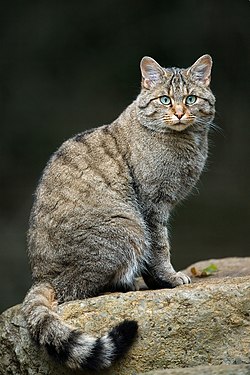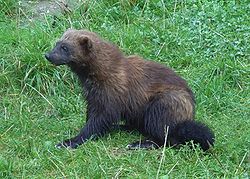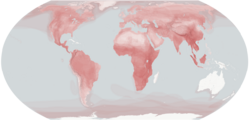The European polecat (Mustela putorius), also known as the common polecat, black polecat and forest polecat, is a mustelid species native to Europe, Western...
64 KB (7,284 words) - 02:40, 5 January 2025
European polecat, M. putorius (Western Eurasia and North Africa) Striped polecat Steppe polecat Black-footed ferret, the “American polecat” European polecat...
3 KB (310 words) - 13:35, 11 February 2025
the European mink is not closely related to the American mink, being much closer to the European polecat and Siberian weasel (kolonok). The European mink...
30 KB (3,532 words) - 23:52, 19 January 2025
steppe polecat (Mustela eversmanii), also known as the white or masked polecat, is a species of mustelid native to Central and Eastern Europe and Central...
20 KB (2,278 words) - 22:26, 22 December 2024
Black-footed ferret (redirect from Black-footed polecat)
size of a mink and is similar in appearance to the European polecat and the Asian steppe polecat. It is largely nocturnal and solitary, except when breeding...
57 KB (6,681 words) - 15:15, 22 March 2025
which is Ukrainian for "polecat".[1] Marbled polecats are generally found in the drier areas and grasslands of southeastern Europe to western China. Like...
13 KB (1,400 words) - 22:06, 15 November 2024
domestic ferret (Mustela furo), the European polecat (Mustela putorius), and the steppe polecat (Mustela eversmanii). Polecats share the genus Mustela with members...
9 KB (891 words) - 08:46, 10 February 2025
A polecat–mink hybrid, also known as khor'-tumak by furriers and khonorik by fanciers, is a hybrid between a European polecat (Mustela putorius) and a...
5 KB (558 words) - 10:32, 5 April 2024
domesticated form of the wild European polecat (Mustela putorius), as evidenced by the ferret's ability to interbreed with European polecats and produce hybrid offspring...
53 KB (5,617 words) - 21:55, 21 March 2025
diverse family of carnivoran mammals, including weasels, badgers, otters, polecats, martens, grisons, and wolverines. Otherwise known as mustelids (/ˈmʌstɪlɪdz/)...
25 KB (2,253 words) - 22:51, 14 January 2025
A polecat–ferret hybrid is a hybrid between a wild European polecat (Mustela putorius) and a domesticated ferret (Mustela furo). Offspring of such a cross...
4 KB (434 words) - 03:37, 25 January 2025
From time to time, it also preys on small carnivores like martens, European polecat, stoat, and least weasel (Mustela nivalis), as well as fawns of red...
44 KB (4,619 words) - 14:33, 10 March 2025
striped polecat (Ictonyx striatus), also called the African polecat, zoril, zorille, zorilla, African muishond, striped muishond, Cape polecat, and African...
70 KB (7,722 words) - 16:26, 29 March 2025
The European pine marten (Martes martes), also known as the pine marten, is a mustelid native to and widespread in most of Europe, Asia Minor, the Caucasus...
19 KB (2,034 words) - 03:33, 22 March 2025
The Scottish polecat (Mustela putorius caledoniae) is an extinct subspecies of European polecat that was endemic to Scotland until its extinction in the...
7 KB (693 words) - 08:53, 10 February 2025
beehives. The skull greatly resembles a larger version of that of a marbled polecat. The dental formula is: 3.1.3.13.1.3.1. The teeth often display signs of...
43 KB (4,834 words) - 02:00, 23 March 2025
nipples but these are more developed in females. European badgers cannot flex their backs as martens, polecats and wolverines can, nor can they stand fully...
69 KB (8,181 words) - 16:15, 6 March 2025
eat fish. The name is instead related to the word "fitch", meaning a European polecat (Mustela putorius) or pelt thereof, due to the resemblance to that...
53 KB (5,940 words) - 06:18, 20 March 2025
gates of the underworld recur throughout Indo-European mythologies and may originate from Proto-Indo-European traditions. In Greek mythology, Cerberus is...
187 KB (17,637 words) - 11:18, 26 March 2025
ecological corridors to connect lesser horseshoe bat sub-populations. The European polecat population in Britain declined following widespread predator control...
22 KB (2,566 words) - 09:53, 22 August 2024
Wolverine (redirect from European wolverine)
of Wolverines (Gulo gulo) in Europe" (PDF). Nature and environment, No. 115. Convention on the Conservation of European Wildlife and Natural Habitats...
62 KB (6,034 words) - 18:34, 28 March 2025
erminea LC Steppe polecat, Mustela eversmanii LC European mink, Mustela lutreola CR (eastern Europe, Spain, France) European polecat, Mustela putorius...
44 KB (3,330 words) - 21:11, 17 January 2025
Beech marten (category Carnivorans of Europe)
crepuscular and nocturnal animal, though to a much lesser extent than the European polecat. It is especially active during moonlit nights. Being a more terrestrial...
25 KB (2,544 words) - 01:28, 4 November 2024
come from this subfamily: ermine, weasel, mink and polecat. COVID-19 can infect both the European mink (Mustela lutreola) and the American mink (Neogale...
7 KB (530 words) - 02:46, 23 January 2025
and prairie polecat. The latter name was originally used by English settlers, who noted the animal's similarity to the European polecat. This association...
30 KB (2,793 words) - 15:02, 25 February 2025
weasel (M. strigidorsa) subgenus Putorius Steppe polecat (M. eversmannii) Ferret (M. furo) Black-footed ferret (M. nigripes) European polecat (M. putorius)...
47 KB (4,425 words) - 07:49, 23 March 2025
predators ambushing or stalking their prey. Wild cats occur in Africa, Europe, Asia and the Americas. Some wild cat species are adapted to forest and...
50 KB (3,927 words) - 22:40, 21 March 2025
The Herpestinae comprises 23 living species that are native to southern Europe, Africa and Asia, whereas the Mungotinae comprises 11 species native to...
39 KB (2,734 words) - 23:06, 30 March 2025
Weasel (category Carnivorans of Europe)
Mustelidae. The genus Mustela includes the least weasels, polecats, stoats, ferrets, and European mink. Members of this genus are small, active predators...
19 KB (1,690 words) - 03:47, 23 January 2025
Eurasian lynx (redirect from European Lynx)
throughout most of continental Europe. By the early 19th century, it was persecuted to local extinction in western and southern European lowlands, but survived...
77 KB (7,918 words) - 20:20, 16 March 2025

